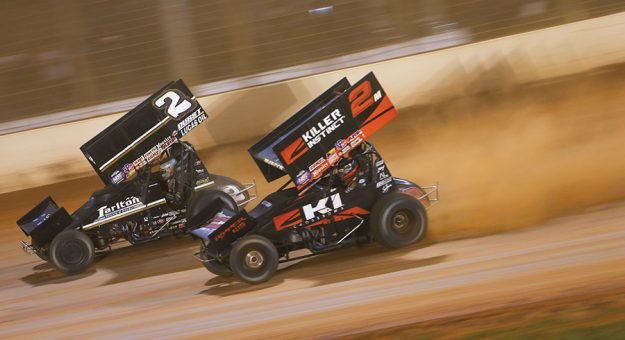HARRISBURG, N.C. — Extremely disappointed when the new clay racing surface at The Dirt Track at Charlotte produced billowing clouds of dust during last fall’s season finales for the World of Outlaws sprint cars and late models, track officials have been working diligently ever since to rectify the problem.
Eric Singhaus, event manager for Charlotte Motor Speedway, recently sat down with SPEED SPORT and detailed what is being done to address the issues with The Dirt Track’s racing surface.
“It’s been quite the process. We started immediately after the World of Outlaws’ Last Call was over in November. We sent three samples of the track surface to a lab we use in California,” Singhaus said. “It was determined the new clay had a significant chemical imbalance. That was mainly in the hydrogen and the pH levels, along with having very minimal organics. Organic matter plays a significant role in the surface of a dirt track.
“The problem we were experiencing during the Outlaws race was once you applied water to the surface, it would soak down into the surface but it would not rise back up. The way our guy in California explained it was that the water would soak all the way down to China,” Singhaus continued. “There was so much water we were putting into it, but it was basically sealing off between the old surface and the new surface. As friction was going across the surface, it was not allowing that moisture to come back up.
“The second issue was the track had a significant amount of hydrogen and a low pH, which would not allow the clay to bond to itself. As a result, those crumbs that were not bonding to themselves or bonding to the track were creating dust.”
Based on the scientific data, officials developed a plan and went to work.
“What we’ve been working on over the winter months and into the spring has been we brought a dozer in and ripped the track up 18 inches deep all the way around from top to bottom,” Singhaus explained. “Then, we applied roughly 70 tons of cotton gin trash and other green waste matter to raise the amount of organic matter in the clay, and then we added lime to help bring our hydrogen and pH levels back to where they need to be.
“The final step was we planted the track with winter rye grass and left the surface open all winter long, meaning we didn’t run the track back in. We left it open so all of that moisture we had in November, December and into January could soak down into the racing surface to help the organic matter decay into the clay.
“This is not an easy process and it’s not going to be a snap your fingers, boom it’s over,” Singhaus added. “This is a lengthy process that’s going to take time, but throughout every race we have and as we keep applying more organic matter to the surface it should correct the dust problem over time.”
As part of the process, a pair of races have been added to The Dirt Track’s schedule.
“We are having races in June and July, both super late model races. We were looking for races with high-powered cars and in the summer months so we could really test the surface to see where our problems are going to be,” Singhaus said. “We know we have problems — we’ve acknowledged that — and we’re working to fix them, but the bottom line is we need to test the surface multiple times throughout the summer and into the fall to make sure we have a good product for November and the return of the World Finals.”
– NASCAR is definitely overdrawn at the luck bank and, eventually, one of these flying race cars at either Daytona or Talladega is going to kill someone. That will be followed by endless choruses of “I told you so.”
Stand up, acknowledge there’s a problem and put in the effort to fix it.
